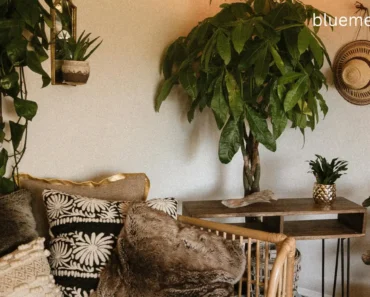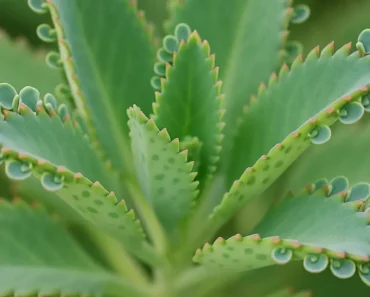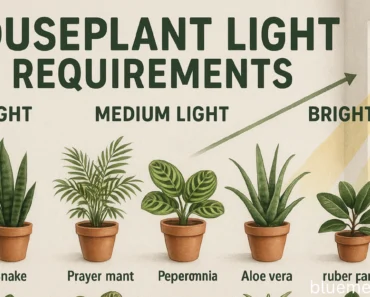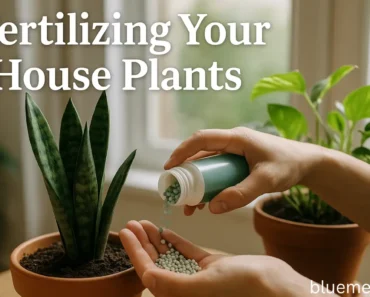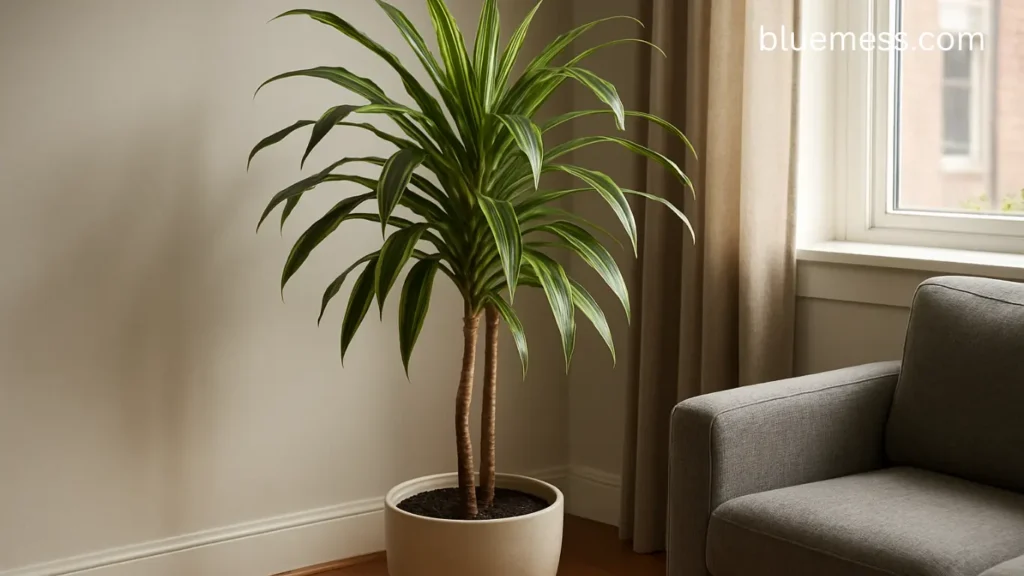
Table of Contents
Introduction: Unlock the Secrets to a Thriving Dracaena
Dracaena plants attract enthusiasts with their bold forms and air-purifying qualities. Despite thriving in low light, they often need specific care to reach their full potential. Whether caring for a Dragon Tree or Corn Plant, understanding dracaena care transforms struggling plants into thriving ones.
This guide covers dracaena lighting and essential care to help you grow healthier plants. Learn the ideal light, watering, soil, and solutions for common problems. With these tips, you’ll keep your dracaena flourishing for years.
Understanding Your Dracaena: A Deep Dive into Varieties and Origins
Origins and Family
The dracaena genus belongs to the Agavaceae family and originates from the tropical and subtropical regions of Africa, Asia, and Central America. These resilient plants have evolved to thrive in warm, humid climates where they receive bright, filtered light beneath forest canopies. This natural habitat provides crucial clues about their care requirements in our homes.
Popular Dracaena Varieties
The world of dracena varieties presents choices for every space and style. The Dracaena Marginata, or Dragon Tree, features distinctive spiky leaves, can reach 6-10 feet indoors, and is noted for drought tolerance. Native to Madagascar, this slow-growing plant adds dramatic vertical interest to any room.
The Dracaena Fragrans, known as Corn Plant, showcases long green leaves with yellow highlights and is valued as an air purifier. This African plant can grow up to 10 feet tall and includes cultivars such as ‘Massangeana’, ‘Bausei’, ‘Lindenii’, ‘Victoria’, and ‘Lisa’, each offering unique leaf patterns while maintaining adaptability.
Other noteworthy dracaena tree types include the vibrant Dracaena Reflexa (Song of India) with its bright green and yellow variegated leaves, the compact Dracaena Surculosa (Gold Dust Dracaena) featuring distinctive yellow-spotted foliage, and the increasingly popular Dracaena Trifasciata (formerly Sansevieria), known as Snake Plant or Mother-in-law’s Tongue. This low-maintenance variety displays upright, sword-like leaves and exceptional air-purifying properties.
The Dracaena Sanderiana, marketed as Lucky Bamboo despite not being true bamboo, offers straight or artfully curled stems and holds special significance in Feng Shui practices. Meanwhile, the Dracaena Deremensis varieties, including ‘Janet Craig’, ‘Compacta’, and ‘Warneckii’, demonstrate remarkable tolerance for low light conditions while maintaining dense, attractive foliage.
Mastering Dracaena Light Requirements: The Key to Vibrant Growth
The Role of Photosynthesis and Chlorophyll
Light is key for dracaena care. Through photosynthesis, dracaenas turn light into growth energy. Without enough light, growth slows. Chlorophyll absorbs blue and red light; variegated types need more light to compensate for less chlorophyll.
Ideal Light Conditions: Bright, Indirect Light
Dracaena plants thrive best in bright, indirect light that mimics their natural forest understory habitat. This lighting promotes vibrant green leaves and balanced growth without the stress of direct sun exposure. In the Northern Hemisphere, east-facing windows provide ideal soft morning sun, while north-facing windows offer consistent, moderate light throughout the day. Southern Hemisphere gardeners should prioritize west-facing windows for similar conditions.
The Dangers of Too Much Direct Sunlight
While dracaena plants appreciate brightness, they strongly prefer dappled light over harsh direct sun. Symptoms of overexposure include pale or yellowing leaves, crispy brown edges, burnt leaf tips, and dry patches developing across the foliage. You might also notice thinning or dropping of older leaves and an overall faded appearance. When these signs appear, immediately relocate your plant to bright, indirect light, use sheer curtains to filter intense rays, rotate the pot regularly for even exposure, and prune away damaged leaves to redirect energy to healthy growth.
Managing Low Light Conditions
Dracaenas tolerate, but do not thrive, in low light. Low light leads to slow growth, pale leaves, legginess, leaf drop, and weak new leaves. Move to brighter indirect light, use artificial lights, and keep leaves clean.
Enhancing Light with Artificial Grow Lights
When natural light proves inconsistent or insufficient, LED grow lights offer an excellent solution. These energy-efficient options can operate for up to 50,000 hours while providing adjustable color spectrums and intensity levels. Choose full-spectrum lights that emulate natural sunlight, ensuring they’re adjustable in both height and angle to accommodate your dracaena tree as it grows.
Precision Lighting with a Light Meter
For those seeking precision in their plant care, a light meter removes guesswork from the equation. Place the meter at leaf level and take readings around noon for consistency. Your dracaena will thrive at approximately 2,000 lux (200 foot-candles), with 1,000 lux (100 foot-candles) representing the bare minimum for healthy growth.
Watering Your Dracaena: Striking the Perfect Balance
The Interplay of Water and Light
Light affects water needs. More light means more water; less light, less water. Knowing this helps prevent watering mistakes.
How Much Water Does Your Dracaena Need?
Dracaenas need less water than many tropical plants. Water every 1-2 weeks, adjusting for season, light, soil, and humidity. Water less in winter and more in summer. These plants are better with too little water than too much.
Recognizing Watering Woes
Overwatering causes wet soil, root rot, yellow leaves, and leaf drop. Underwatering leads to dry soil, brittle stems, and crispy leaves. Let soil dry fully between waterings and ensure drainage.
Best Watering Practices
Dracaenas are sensitive to fluoride and chlorine. Use filtered or distilled water. Water when the top half of the soil is dry, soaking until water drains but never allowing the plant to sit in water.
Soil and Potting Essentials for Healthy Roots
The Ideal Potting Mix
Success with dracaena plants begins with proper soil selection. The ideal mix balances air circulation with moisture retention, typically containing perlite, pine bark, or coarse sand for drainage. Commercial mixes labeled for tropical plants or succulents work well, but avoid heavy garden soils that retain excessive moisture.
Repotting Your Dracaena
Repot dracaenas every 2-3 years in spring, using a container 1-2 inches wider. Remove dead roots, refresh soil, and water well.
Creating the Perfect Environment: Temperature and Humidity
Keep dracaenas at 65-80°F (18-27°C), never below 55°F (13°C). Avoid drafts and sudden temperature changes.
Keep humidity at 40-60% to prevent brown tips. Use misting, water trays, plant grouping, or a humidifier in dry seasons.
Feeding Your Dracaena: Fertilization Best Practices
Use balanced fertilizer (10-10-10 or 20-20-20) every 4-6 weeks in growing season. Feed less or stop in fall and winter, diluting more than recommended.
Essential Maintenance: Pruning and Propagation
Prune regularly to control size and encourage growth. Use clean shears above leaf nodes. Propagate by putting stem cuttings in water or soil until they root.
Troubleshooting Common Dracaena Problems
Yellow leaves signal overwatering, poor drainage, nutrient loss, or too much sun. Brown tips mean low humidity, fluoride, over-fertilizing, or underwatering. Adjust care and trim damaged leaves.
Advanced Tips for Dracaena Success
Change routines with the seasons: less water in winter, more in summer. Self-watering pots help. Move outdoors only when above 60°F.
Dracaenas are toxic to cats. Keep them out of reach. Rare indoor blooms appear with mature, well-cared plants.
Conclusion: Your Dracaena, Thriving Year-Round
Thriving dracaenas need the right light, water, and environment. Watch the plant’s signals and adjust care as needed. With these tips, enjoy beautiful, healthy plants and join fellow plant owners on your care journey.
Author
George Wine is a seasoned gardening expert with over 20 years of experience in the field of horticulture. His passion for plants and nature has driven his career, where he has honed his skills in various aspects of gardening, from landscape design to plant care. George holds a Master of Science in Horticulture from the University of California, Davis (UC Davis), a prestigious institution known for its research and advancements in plant science.
Throughout his career, George has worked with a diverse range of clients, offering tailored solutions to enhance outdoor spaces and create thriving gardens. His knowledge and expertise allow him to provide invaluable advice, ensuring that both novice and experienced gardeners achieve their gardening goals. Whether you’re looking for tips on sustainable gardening practices, innovative design ideas, or advice on specific plant species, George is here to help you cultivate the garden of your dreams.

